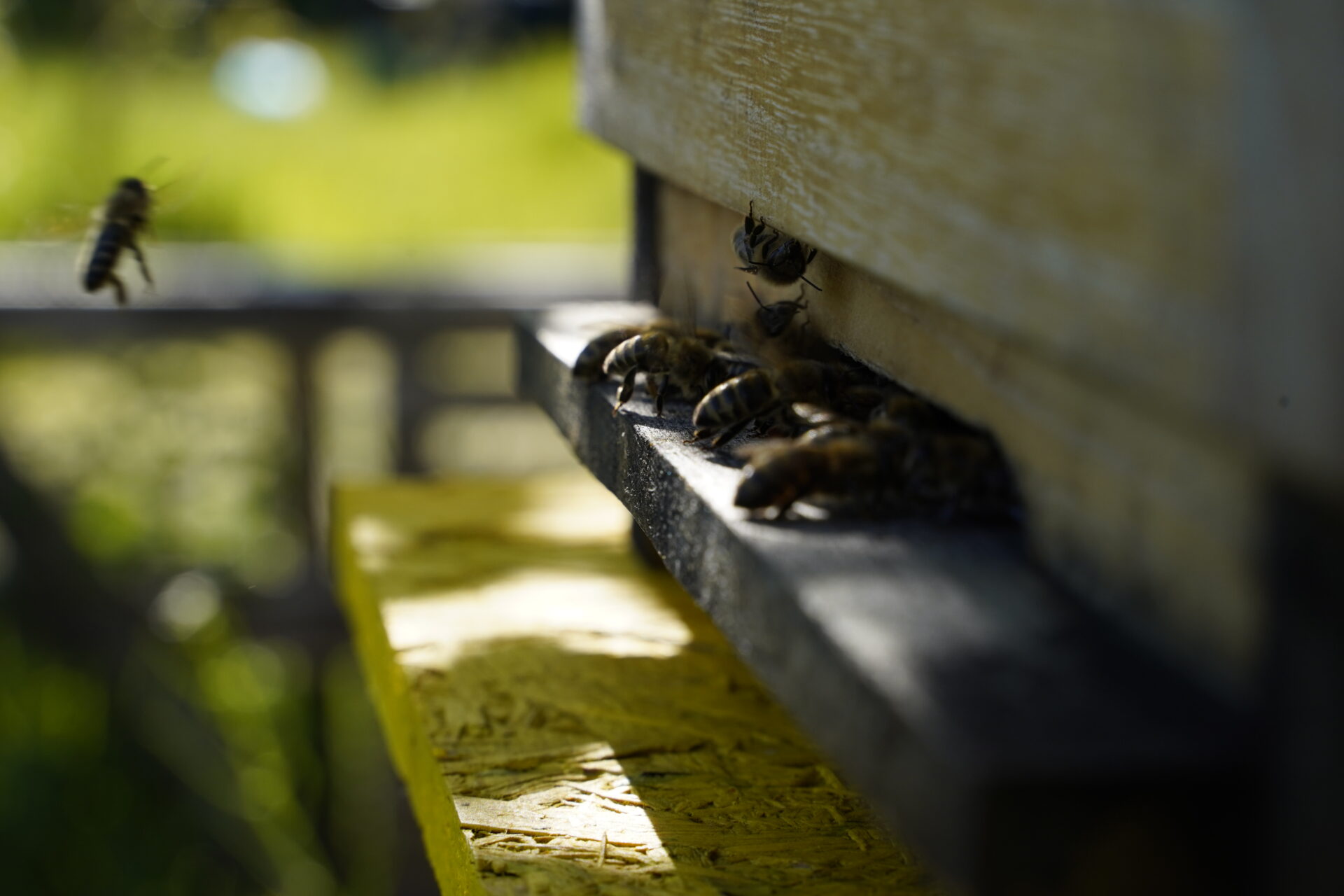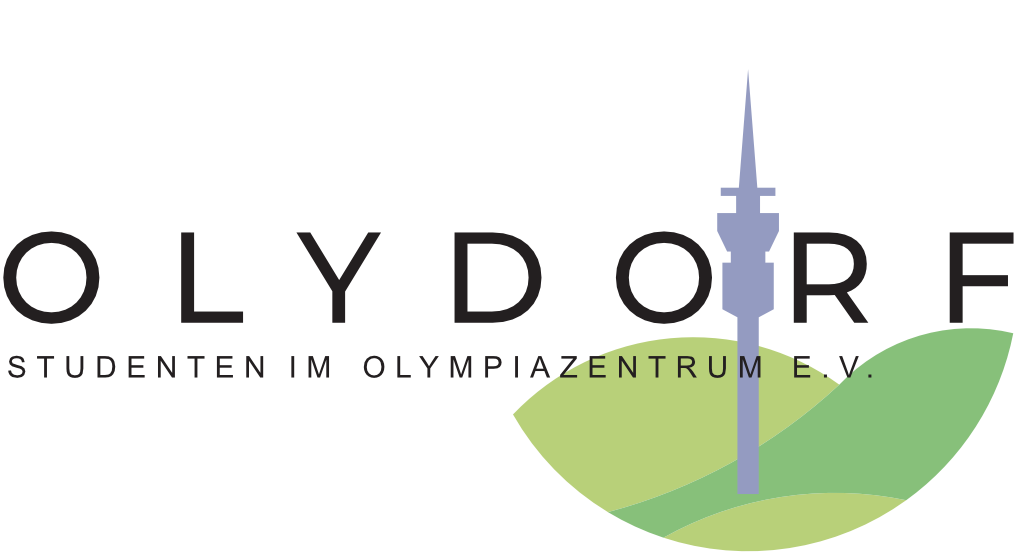Bees in the Olympus
Bees
The honeybee, our primary focus, is only one of over 500 different bee species in Germany. Whereas the honeybee is a domesticated bee, the others are wild bees such as the bumblebee and the mason bee.

The majority of them, contrary to the honeybee, live as hermits, yet they still play their part in the pollination of flowers and blossoms, some are even highly specialised that they can only pollinate specific plants.
Wild Bees
There are 561 different species of bees in Germany, over half of them are red-listed! Even though 80% of pollination is done by honeybees, wild bees are equally important. Many rare plants are pollinated by wild bees, as they are more specialised on them, some even can be only pollinated by a specific species. These plants, in return feed other insects. Hence, harming the (wild) bees would harm the whole ecosystem. For example, the decline in bird population can be traced back to the 70% decrease in insect biomass, which in turn is caused by pesticides and less green spaces.
Nesting aids
With the development of lawn mowing robots, the construction of sterile rock gardens, and the rapid removal of bogwood, wild bees are unfortunately deprived of many natural nesting sites. We want to raise awareness of this and continue to build new hiding places for them throughout the year. The nests of wild bees are built in reeds, in loamy soil, in partially rotten logs, or hollowed-out tree trunks. We are also developing a wild bee nesting aid specially adapted to our Olympic Village bungalows in cooperation with the Workshop Committee and the Pottery Committee. Many different regional species will be able to nest here. In this way, we are giving wild bees back a habitat that has unfortunately been lost in the big city.
Wildflower Meadow
To make our Olydorf a little more beautiful, but of course also to create a food source and home for our wild bees, honey bees, and many other insects, such as butterflies and beetles, we beekeepers have decided to plant wildflower meadows with nesting opportunities.
One of these is at the end of U-Gasse, along with the beekeeping garden being developed there. Other wildflower strips and nesting aids are on our Olympic Park bee stand.
Requiring neither fertilization nor pest management, this wildflower meadow offers an easy way to promote soil diversity and looks pretty.
It was sown in the spring of 2019 and 2020, as the ideal time for sowing should be in wet weather so there is enough moisture for the seeds to germinate. Some wildflowers are so-called cold germinators, so in the following year in the spring, they show their full flowering glory.
We would also like to plant wildflower meadows in other places around Olydorf to provide our regional wild bees with a diverse food base. In the age of monocultures, they can collect varied nectar from us.
Bumblebee Nesting Boxes
Well, which insect flies so conspicuously low in zigzag over the ground? And why?
If you have also pondered this question during a little spring garden tour, the explanation is quite simple:
Usually, bumblebees are one of the first animal guests in our gardens. Unlike honey bees, where the whole colony, consisting of queen and winter bees, always survives the winter, in bumble bees, except for the already mated young queen, all other animals die in the fall. In early spring, starting in February and with temperatures as low as 2°C, these young queens search for nesting sites. For this purpose, dead wood piles, stone crevices, and mouse holes are thoroughly inspected, sometimes bird nests or house insulation. Sometimes even one or other mouse has to clear its nest for the pugnacious bumblebee queen "fat Berta"!
Once the perfect spot is finally found, they begin establishing a new colony of bumblebees.
At first, the young queens still feed on food stocks from the previous year, which they have stored in their honey stomachs. Soon, however, the stocks are used up. Only to be able to start the breeding season optimally is it crucial that nectar-donating and pollen-rich flowers are available in time.
We students of the "Bienen im Olymp" have also prepared for these guests. Thus, three bumblebee nest boxes made of wood as a dioecious system are already available for our young bumblebee queens since last year, 2019. In the coming season, we want to build more bumblebee nest boxes in cooperation with the pottery committee of the Olympic Village. We have chosen a well-air-conditioned bumblebee sphere made of clay/ceramics.
These nest boxes are ideal for most species of bumblebees so that we can count on the visit of the
large earth bumblebee – Bombus terrestris: common bumblebee species, two narrow dark yellow transverse bands on the thorax near the head (thoracic area, starting just behind the head) and on the 2nd tergite (dorsal plate of the abdomen (abdomen)) with white colored abdominal end),
the white-tailed bumblebee – Bombus lucorum: easy to confuse with the large earth bumblebee. The difference is the two bright yellow lines on their thorax, one on their abdomen and a white end. Tergiten (Rückenplatte des Abdomens (Hinterleib)) und ebenfalls weiß gefärbter Hinterleibsende) und
the red-tailed bumblebee (Bombus lapidarius: the females are mainly black with a distinctive dark redabdomen. But we are hoping for many other species to come!
Spells of bad weather really rankle with our indigenous bumblebees - many a times there is a food shortage looming. If you encounter an exhausted queen bumblebee, you can easily help the weary traveller out with half a teaspoon of sugar dissolved in some warm water.
Helping a single queen bumblebee in early spring can save not just her majesty but an entire upcoming colony.
However, when encountering an exhausted honeybee, don't feed it sugar. The life of a bee is designed to spend its later part of life outside and collect pollen and nectar and eventually die outside not to spread diseases in the colony. So save your sugar and make yourself a chai instead!
Bee gums
DUE TO TOO MUCH EFFORD WE ABANDONED THIS PROJECT - FOR YOUR PROJECT WE CAN HELP WITH OUR EXPERTISE
For eons, the traditional housing of the honeybee has been a hollowed out tree whose prior inhabitants (bats and birds) have left their nests. In the olden times the honey hunter or apiarist was harvesting the the honey from these hollow trunks, destroying the colony in the process. 3000 years ago, humans have started domesticating bees in baskets and later wooden boxes. This laid the foundation for beekeeping as we know it today.
However, this modern form does not allow us to study bees in their natural habitat. Thus we wanted to try building such a bee gum. We wanted to hollow out a tree trunk and prepare it for a colony to house in. Here it was supposed to build its own combs without us interfering, making it easier for natural ventilation to occur. From a beekeepers perspective it is very hard to support such a colony.
Queen Rearing
Since the 60's, german beekeeping is dominated the Apis mellifera carnica race. These bees have been domesticated by breeding for its favoured traits such as high honey output, colony size and resilience against the varroa mite, diseases and winter hardiness. Additionally traits such as readiness to swarm and gentleness are other important factors. The latter is very important for us to give tours. The controlled rearing process is organised and conducted by the German Beekeepers Association, the different Bee-Institutes and many well-versed breeders. In 2019, we sent our Queens to alps for their honeymoon where they had their mating flight.
Beehive scale
With the international research project "HOBOS (HOneyBeeOnline-Studies" (pun probably intended) headed by Prof. Tautz of the University of Würzburg, intelligent scales, a way of measuring the beehive are being built. Thanks to modern technology, we can measure and record humidity, air pressure, activity of the bees and the hive's weight, temperature and moisture.
Similar to the researchers from Würzburg, we also want to utilise these scales and webcams to monitor our girls around the clock without their knowledge. This helps us to work on the colonies in a more coordinated manner.
For us, this lightens our workload at the beehive thanks to the variety of measurements. For instance: the daily air traffic can be monitored by the variation in weight and at which time of day the bees are looking the most for pollen and nectar. Additionally, the measurements allow us to monitor the hive's vitality in winter by measuring the temperature in the brood chamber, thus giving a hint of the queen's breeding activity. This in turn helps us determine when no breeding occurs so we can do necessary procedures.
Useful side effects included are, by measuring the weight discrepancy to the prior day, the amount of honey harvested. A sudden drop in weight can determine a possible theft or swarming of a part of the colony.
For visitors, there is a bonus as well, you can get around the clock access to our data so that you can understand the highly complex processes and the behaviour of the honeybee.
Currently, a prototype with sensors for weight, temperature, humidity and air quality is being made. This will be powered by a solar panel operated HoneyPi soured from a Raspberry Pi Zero.
Eventually the access to our webcams and data will be accessible on this site.
Swarming Bees
There comes a time where even the most innocent of bee colonies wants to reproduce. Hereby a colony splits up and the old queen leaves accompanied by a swarm of about 10,000 bees.
Not just humans have realtors, bees have seeker bees that will try to find a suitable location. But as this is Munich, a 500€ spot on the kitchen cabinet is maybe not the best location, so if you encounter such a swarm in the wilderness of Munich, please go to https://schwarmrettung.de/
After reporting the swarm, why don't you take some time off your busy schedule and enjoy this marvel of nature?
Don't be afraid, a swarm on house-hunting, like us, is exhausted and is very unlikely to sting you. But still, don't put your hand in it.
